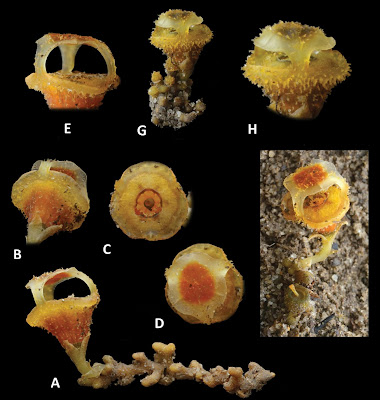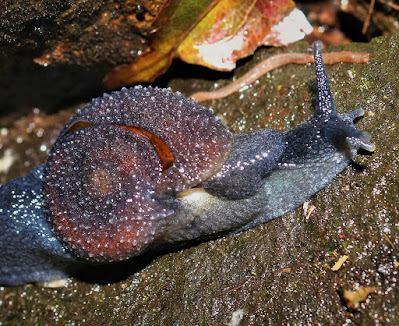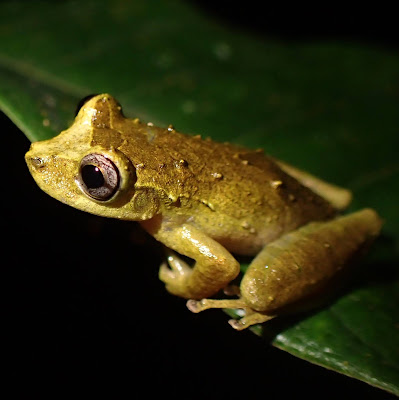[Most Recent Entries] [Calendar View]
Wednesday, June 30th, 2021
| Time | Event | ||||
| 1:27a | [Botany • 2021] Thismia sitimeriamiae (Thismiaceae) • An Extraordinary New Species from Terengganu, Peninsular Malaysia
Abstract We describe an extraordinary new species in the genus Thismia from the Terengganu State of Malaysia in the Malay Peninsula. The new species, which we name Thismia sitimeriamiae, is distinct from all other Thismia species known to science, most notably in its unique mitre configuration formed by the inner tepals and its floral surface morphology characterised by conspicuous orange trichomes. We discuss our findings in the context of underestimated species diversity in the genus Thismia and implications for their conservation. We recommend assigning T. sitimeriamiae the conservation status as Critically Endangered (CR) according to IUCN criteria. Keywords: conservation, forestry, mycoheterotrophy, species diversity, taxonomy
Thismia sitimeriamiae Siti-Munirah, Dome & Thorogood, sp. nov. Diagnosis: Thismia sitimeriamiae has a unique combination of morphological traits, by which it differs from all its congeners including its orange colour, its surface characteristics and its floral architecture: the flower is strigose with pale orange simple and stellate trichomes covering the outer surface of the floral tube, mitre and ovary; the upper surface of the annulus is covered by very short trichomes; the outer tepals are reduced and inconspicuous and the inner tepals are curved upwards, connate, forming an umbrella/parasol-like mitre with a flattish apex. Distribution: Endemic to Terengganu, Peninsular Malaysia. Currently known only from the type locality (Map 1). Ecology: Lowland dipterocarp forest on moist soil in shade at an elevation of 209 m a.s.l. Flowering and fruiting from December to February. Etymology: Thismia sitimeriamiae is dedicated to Siti Meriam, the mother of the second author (Dome Nikong), in honour of her unparalleled support for the conservation activities pursued by Dome Nikong and her help in maintaining his plant collections.  Mat Yunoh Siti-Munirah, Nikong Dome and Chris J. Thorogood. 2021. Thismia sitimeriamiae (Thismiaceae), An Extraordinary New Species from Terengganu, Peninsular Malaysia. PhytoKeys. 179: 75-89. DOI: 10.3897/phytokeys.179.68300 | ||||
| 8:05a | [Mollusca • 2021] Varadia amboliensis • A New Helicarionoidean Semi-slug Genus (Stylommatophora: Helicarionoidea) from India’s Western Ghats
ABSTRACT We here describe a new Indian helicarionoidean genus, Varadia Bhosale & Raheem gen. nov., containing the single species Varadia amboliensis Bhosale, Thackeray, Muley & Raheem gen. et sp. nov. This new semi-slug is endemic to the northern and central Western Ghats and is primarily a forest-living species. We describe and figure the shell, reproductive system, radula, spermatophore and external morphology of this new species, and detail its known distribution. We explore its relationships to other helicarionoideans using phylogenetic analyses of DNA sequence data for part of the ribosomal RNA gene cluster and discuss the morphology of the new genus in relation to other, primarily South Indian, helicarionoidean taxa. Based on characters of the reproductive system, particularly the male genitalia and the gametolytic sac, we provisionally place Varadia gen. nov. in the Macrochlamydinae (Ariophantidae). This is consistent with the results of our molecular phylogenetic analyses. The combination of large size, broad, densely tuberculated shell lobes and a shell with ca 4 whorls and a disproportionately large body whorl makes V. amboliensis gen. et sp. nov. unique among the helicarionoidean taxa of the Western Ghats. The new semi-slug is also highly distinctive in the morphology of its male genitalia. Keywords: Varadia amboliensis gen. et sp. nov., Macrochlamydinae, taxonomy, phylogenetics, ribosomal RNA gene cluster
Phylum Mollusca Linnaeus, 1758 Class Gastropoda Cuvier, 1795 Subclass Heterobranchia sensu Bouchet et al., 2017 Order Stylommatophora sensu Bouchet et al., 2017 Superfamily Helicarionoidea Bourguignat, 1877 Family Ariophantidae Godwin-Austen, 1888 Subfamily Macrochlamydinae Godwin-Austen,1888 Varadia Bhosale & Raheem gen. nov. Diagnosis: Only known large semi-slug species from the Western Ghats having broad shell lobes (covering nearly all of the dorsal shell surface when fully extended) and a depressed, discoid shell with a large body whorl. Shell thin, glossy golden brown, with 4–4½ rapidly increasing whorls and barely raised spire. Extensive, largely free penial sheath enclosing substantial part of male genitalia. When sheath is in situ and penis in relaxed state, male genitalia constitute a single elongate, irregularly-shaped mass, with all of penis and epiphallic caecum, most of epiphallus and part of flagellum enclosed by sheath; only vas deferens and most of flagellum is visible outside intact sheath. Penial sheath divisible into thick proximal part and thin distal part, with transition between these two parts occurring between distal penis and epiphallic caecum. With penial sheath removed, following evident: region extending from penis to epiphallic caecum long and cylindrical, with distinctive S-shaped bend in penis and associated band of muscle running along length of penis; proximal ¾ of epiphallus held in long, conspicuous loop; and penial retractor muscle with two branches, one inserting subterminally on epiphallic caecum and one inserting on apex of loop of epiphallus. Inner wall of penis divisible into three regions: proximal penis (one major and several minor longitudinal pilasters), mid-penis (several minor longitudinal pilasters) and distal penis (a few minor pilasters with associated regular transverse ridges in interspaces). Inner wall of epiphallic caecum shows one long major longitudinal pilaster, a large mass of reticulate ridges proximally and several minor longitudinal pilasters distally. Gametolytic gland elongated and long; gametolytic sac 3–3.5 times as long as gametolytic duct. Amatorial organ absent. Spermatophore consists of elongated, soft capsule and long tail-pipe, with U-shaped bend at capsule–tail-pipe junction and funnel-like opening at tip of tail-pipe; surface smooth apart from four ribs running obliquely along length of tail-pipe and short spines near end of tail-pipe. Etymology: The new genus is named in honour of the herpetologist Dr Varad Giri, who has made a major contribution to the modern study and conservation of the Indian herpetofauna; masculine. Varadia amboliensis Bhosale, Thackeray, Muley & Raheem gen. et sp. nov. Etymology: Named after the type locality, Amboli, in the Sindhudurg District of southern Maharashtra, India. In recent years, Amboli has emerged as a hotspot for the discovery of new species (particularly reptiles and amphibians) in the northern Western Ghats. Amrut R. Bhosale, Ahmed J. Saadi, Christopher M. Wade, Tejas U. Thackeray, Asif S. Tamboli, Suhas K. Kadam, Dipak V. Muley and Dinarzarde C. Raheem. 2021. Varadia, A New Helicarionoidean Semi-slug Genus from India’s Western Ghats (Stylommatophora: Helicarionoidea). European Journal of Taxonomy. 757(1), 50-79. DOI: 10.5852/ejt.2021.757.1413 | ||||
| 8:14a | [Herpetology • 2021] Scinax pixinguinha • A New Species of Scinax Wagler (Anura, Hylidae) from the Atlantic Forest, Southeastern Brazil
Abstract The Scinax catharinae clade comprises the S. perpusillus and S. catharinae groups. The S. catharinae group has 38 species, mostly from Brazil's Atlantic Forest. We describe a new species of S. catharinae group based on external morphology, color pattern, and bioacoustics. The new species calls from herbaceous vegetation of slow-flowing streams from Santa Teresa, State of Espírito Santo, southeastern Brazil. The new species is distinguished from species of the S. catharinae group by the following combination of characters: male SVL 24.8–28.3 mm and female SVL 31.2–38.6 mm; males with hypertrophied forearms and inguinal glands; interocular region with a dark blotch not exceeding beyond the anterior margin of tympanic level; black blotches on a whitish-green background on the inguinal region and hidden surfaces of legs; call type A of 0.301–0.883 s, and 12–30 notes emitted at a rate of 31.4–42.0 notes/s. We also provide remarks on its natural history and conservation status.
Scinax pixinguinha, new species Etymology.— Alfredo da Rocha Vianna Filho (1897–1973), popularly known as Pixinguinha, was a Brazilian musician and the most famous Choro player. Choro or Chorinho is a Brazilian genre of popular music originated in the 19th century. In Portuguese Choro or Chorinho means ‘‘cry’’ or ‘‘little cry,’’ respectively. Ironically, Chorinho is a contagious music commonly played during joyous moments in Brazil. Brazilians usually say Pixinguinha was a kind of magician who learned how to convert tears of Choro (cry) into tears of happiness. Because 72% of the Atlantic Forest original cover has been deforested, discoveries of new species also has the power to momentarily change part of our conservationist sadness into happiness and motivation. Thus, the specific epithet of S. pixinguinha is a noun in apposition in honor of the talented Brazilian musician—Pixinguinha. João Victor Andrade Lacerda, Rodrigo B. Ferreira, Katyuscia Araujo-Vieira, Cássio Zocca and Ana Carolina C. Lourenço. 2021. A New Species of Scinax Wagler (Amphibia, Anura, Hylidae) from the Atlantic Forest, Southeastern Brazil. Ichthyology & Herpetology. 109(2); 522-536. DOI: 10.1643/h2020091 |
| << Previous Day |
2021/06/30 [Calendar] |
Next Day >> |
















